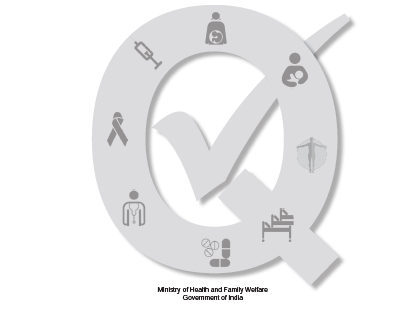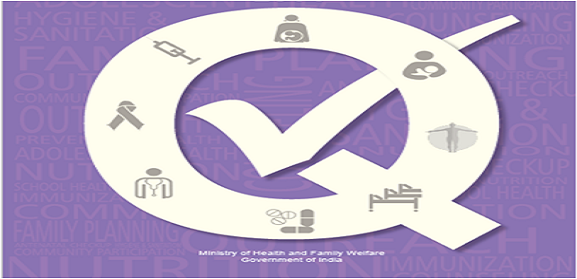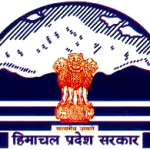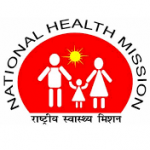Quality Assurance Programme
Introduction to Quality -:
The National Rural Health Mission (NRHM) was launched in the year 2005 with the goal “to improve the availability of and access to quality health care for people, especially for those residing in rural areas, the poor, women and children.” The Mission has led to considerable expansion of health services through rapid expansion of infrastructure, increased availability of skilled human resources and greater local level flexibility in operations, increased budgetary allocation and improved financial management. However, improvement in Quality of health services at every location has not been perceived, generally. Perceptions of poor quality of health care may, in fact, dissuade patients from using the available services because health issues are among the most salient of human concerns. Ensuring quality of the services will result in improved patient / client level outcomes at the facility level. Ministry of Health and Family Welfare, Government of India is committed to support and facilitate a Quality Assurance Programme, which meets needs of Public Health System in the country and is sustainable. Main focus of proposed Quality Assurance Programme would be enhancing satisfaction level among users of the Government Health Facilities and reposing trust in the Public Health System.
Guidelines -:
A Quality based approach helps in identifying the gaps in service delivery and tracing its roots and linking them to organisational processes. It builds a system of taking effective actions for traversing the gaps, periodic assessment and improving the quality. The Quality Assurance Guidelines have been developed by the Ministry of Health & Family Welfare for addressing the concerns of public, and also the technical components of service delivery in a comprehensive manner. The guidelines define ‘road-map’ for implementing quality assurance in the States. The QA approach suggested in these documents will help in improving the quality standards of public health facilities in the country. The States are required to meet the minimum standards defined in the guidelines. Once these standards are met, subsequently they may go for higher standards. The guidelines have two parts the first one is for organisational framework, while the second volume is an assessment tool.
a.) Operational Guidelines for Quality Assurance is best used for strengthening Quality Assurance System, from state level to facility level, which would essentially include a supportive institutional framework & organisational structure, adoption of the standards, a system of continuous assessment of health facilities, action planning for closure of ‘gaps’/ ‘deficiencies’, supportive supervision and lastly, external assessment of the facilities for certification.
b.) Assessors’ Guidebook (Volume I & II) is compendium of the check list for each department of a health facility, which would be used for internal assessment by the facility, the DQAC/DQAU, and by the SQAC/SQAU for arriving at a quality score for each facility. Same checklists would also be used for certification by the external/internal assessors. The State Quality Assurance Committee may make certain check-points as optional to have ‘flexibility’; and in
subsequent years it could be converted into mandatory and included into the Quality plan. Completion of the check-lists would generate a scorecard for each facility. These check list include a client feedback form (exit interview) to assist the assessors and understand how closely the services fulfil the ‘felt need’ of the people. The score-cards could also be used for having intra-state and inter-state comparison.
The purpose of these guidelines is to enable all personnel working in the Public Health System to have a credible quality assurance programme, so that health facilities not only provide full range of services, which are committed in the National Health Programmes, but also ensure that the services meet verifiable and objective quality standards.
The state/districts/facilities may phase activities under quality assurance programme, both in term of number of facilities, and within a facility, certain areas could be identified for ensuring quality assurance
initially within a given time-frame. All efforts should be made in achieving these targets and sustaining them in subsequent years.
Scope of the Guidelines -:
‘Operational Guidelines on Quality Assurance’ and accompanying volumes of ‘Assessment Tools’ have been prepared for minimum health services, which should be available at a District Hospital, including those in the arena of Reproductive, Maternal, Neonatal, Child and Adolescent Health (RMNCH+A) and Disease control programmes. While the structure of QA proposed here is for all areas of health services, however the check-list for assessing health facility is at present focussed on RMNCH+A and related support services. It is open for expansion and inclusion of other areas in the course of laying down a roadmap for QA in the states.
Operational Guidelines on Quality Assurance has following four sections -:
1. Section A: ‘Understanding Quality Assurance’ describes concept of Quality Assurance, as relevant to Public Health System, framework of Quality of Care and generic description of the approach.
2. Section B: ‘Organisational Structure for Quality Assurance’ dwells into the proposed organisational structure for supporting QA at state and district level along with their ToRs.
3. Section C: ‘Road Map’ describes the sequential steps, which need to be taken by the States, districts and health facilities for implementing the Quality Assurance Programme.
4. Section D: ‘Standards & Measurable Elements’ describes minimum standards, which a district hospital should meet. Each standard has sub-components for measuring them. While standards will remain the same but the check points will vary for the facilities below the district hospital i.e. CHC, PHC etc.





